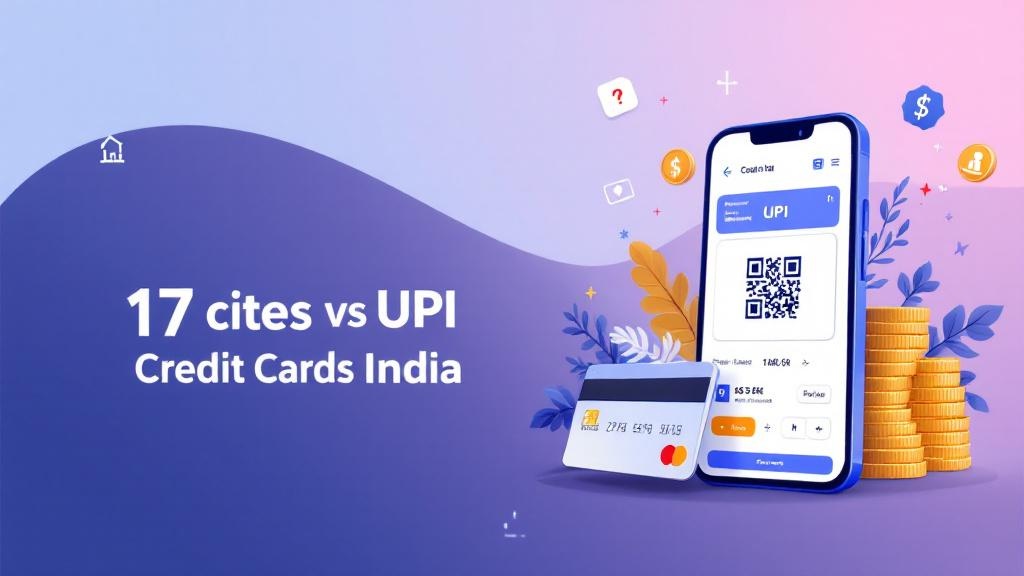In recent years, India has witnessed a remarkable shift in its payment landscape, with two dominant payment methods: Unified Payments Interface (UPI) and credit cards. These payment options have become crucial for individuals and businesses alike, reshaping how transactions are made across the country. But, with UPI’s meteoric rise, how does it stack up against credit cards in India? In this article, we will compare UPI vs credit cards in India, focusing on the advantages, disadvantages, and trends that will shape the future of digital payments.
By the end of this article, you’ll have a clear understanding of which payment method is best suited for your needs in 2025, whether you’re looking for a secure payment option in India, interested in QR code payments, or simply exploring the best payment method in India 2025.
UPI vs Credit Cards in India: A Digital Payments Comparison
In India, the rise of digital payments has been nothing short of revolutionary, thanks to platforms like UPI and credit cards. Both have their strengths and drawbacks, and understanding these nuances is crucial for consumers and businesses alike.
What is UPI?
Unified Payments Interface (UPI) is a real-time payment system developed by the National Payments Corporation of India (NPCI). It allows users to link multiple bank accounts to a single mobile application and facilitates instant bank transfers using only a mobile number or a QR code.
Since its launch, UPI has become an integral part of the Indian financial ecosystem, providing a cashless payment system in India with enhanced security features like two-factor authentication.
What is a Credit Card?
A credit card allows individuals to borrow funds from a bank or financial institution up to a certain limit. These cards offer the flexibility to make purchases and pay later, typically within a 30-day billing cycle, to avoid paying interest.
Credit cards often come with reward points, cashback offers, and other perks, making them an attractive choice for those who can manage their credit responsibly.
The Benefits and Drawbacks of UPI
UPI’s advantages and disadvantages have become a hot topic of discussion among consumers. Let’s break down the major factors.
Advantages of UPI
Instant Payments: UPI facilitates instant bank transfer in India, making it highly popular for day-to-day transactions.
No Hidden Charges: Unlike credit cards, UPI does not charge any processing fees on transactions. It’s a free payment method for consumers and businesses.
Security: With features like two-factor authentication and a PIN, UPI ensures that your transactions are secure.
Convenience: UPI is available 24/7, making it an ideal payment method for both personal and professional use.
Cashback and Rewards: Many UPI platforms like the BHIM app offer cashback on transactions, incentivizing users to adopt this payment method.
Disadvantages of UPI
UPI Daily Transaction Limit: One of the limitations of UPI is the daily transaction limit, which restricts users from making high-value transactions. For instance, most UPI platforms have a daily limit of ₹1 lakh, which might not suffice for larger transactions.
Dependency on Mobile Network: While UPI is convenient, it requires an active internet connection and a mobile number, which can be a barrier for some users in rural areas with limited connectivity.
Bank Integration Issues: While most banks support UPI, occasional technical glitches can make it frustrating for users when transferring money.
The Benefits and Drawbacks of Credit Cards
Credit cards come with their own set of advantages and disadvantages. Let’s explore what makes them appealing and where they might fall short.
Advantages of Credit Cards
Credit Building: Using a credit card responsibly can help you build a credit score in India, which is vital for future loans and other financial activities.
Credit Card Benefits Over UPI: One of the primary benefits of credit cards over UPI is the ability to buy now and pay later. This flexibility can be beneficial for emergency purchases or large-ticket items.
Rewards and Cashbacks: Credit cards are known for their reward points and cashback offers. Depending on your spending habits, you can earn significant benefits by using your credit card.
High Transaction Limit: Unlike UPI, credit cards allow for larger transactions, which is ideal for individuals making high-value purchases.
Disadvantages of Credit Cards
Credit Card Fees in India: While credit cards offer numerous perks, they often come with high interest rates and annual fees. If you don’t pay off your balance in full, interest charges can add up quickly.
Potential Debt Risk: If not used wisely, credit cards can lead to accumulating debt, particularly if users are unable to repay their monthly dues.
Security Concerns: Credit cards can be prone to fraud if lost or stolen, although this is mitigated by security features like two-factor authentication and credit card PINs.
UPI vs Credit Cards in 2025: Which is the Better Payment Method?
As India moves towards becoming a cashless economy, both UPI and credit cards will continue to play pivotal roles. However, their growth trajectories are likely to differ based on several factors:
Digital Payments Adoption in India: With fintech adoption on the rise, UPI is poised to dominate the payment gateway sector, especially for QR code payments. The best payment method in India 2025 will likely favor UPI for everyday transactions due to its simplicity and zero fees.
Credit Card Usage: Credit cards will still remain relevant for users who prefer credit card rewards vs UPI cashback, as they offer additional perks like travel rewards, points redemption, and exclusive discounts.
UPI’s Dominance in Rural Areas: UPI has gained significant traction in rural India, thanks to its easy-to-use interface and low transaction costs. As smartphones become more widespread, UPI could surpass credit cards in rural areas by 2025.
Frequently Asked Questions (FAQs)
1. Is UPI the best payment method in India 2025?
Yes, UPI is expected to be the best payment method in India 2025, thanks to its low transaction costs, instant payments, and ease of use.
2. What is the UPI daily transaction limit?
The UPI daily transaction limit is typically ₹1 lakh for most banks, but it can vary depending on the platform and your bank’s policies.
3. Do credit cards offer more benefits than UPI?
Credit cards offer rewards points, cashback, and interest-free credit periods, while UPI provides instant payments and zero transaction fees. However, UPI is better for daily transactions, while credit cards excel for high-value purchases and benefits.
4. How do credit cards affect my credit score in India?
Using a credit card responsibly can help improve your credit score by showing that you can manage debt. However, missing payments or maxing out your credit limit can hurt your credit score.
5. Is UPI safe to use for online transactions?
Yes, UPI is safe for online transactions, thanks to features like two-factor authentication and PIN protection. However, always ensure you are using a trusted app and avoid sharing sensitive information.
6. How does UPI compare to debit cards?
Both UPI and debit cards allow for direct bank transfers, but UPI is generally more convenient as it allows you to link multiple accounts to a single app and supports instant transfers.
7. What are the key differences between UPI and credit cards in India?
The main difference lies in payment flexibility. Credit cards offer a buy-now-pay-later option, while UPI requires funds to be available immediately for the transaction. Additionally, credit cards come with annual fees and interest rates, while UPI is free to use.
Conclusion: UPI vs Credit Cards in India – Which One Wins?
Both UPI and credit cards will continue to be integral to India’s digital payments ecosystem. UPI is likely to emerge as the preferred payment method for everyday transactions due to its zero fees, instant transfers, and ease of use. However, for large purchases, credit cards will still offer benefits like cashback, rewards, and the ability to build a credit score.
In the future, a combination of UPI and credit cards may prove to be the ideal solution for consumers, offering the best of both worlds. Whether you’re paying for groceries with UPI or booking a flight using your credit card, understanding the strengths and weaknesses of each payment method will help you make more informed choices.
Meta Description: Compare UPI vs Credit Cards in India for 2025. Explore the advantages, disadvantages, and key differences, and find out which payment method is best suited for you.








Comments (0)